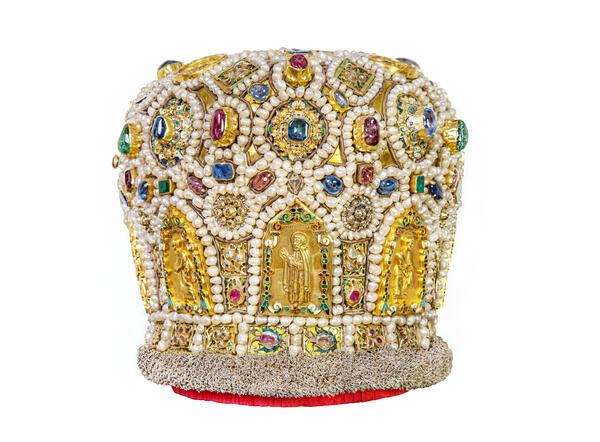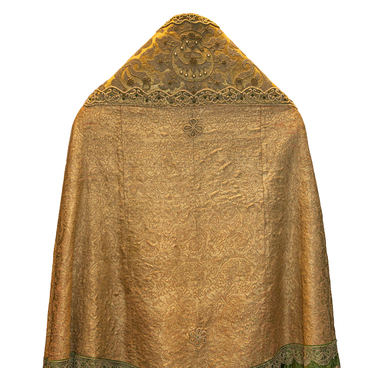The mitre is a headdress, part of the liturgical vestments of a bishop, an archimandrite (the highest rank of monastic priests), as well as some other clergy. The abbots of the the Trinity-St. Sergius Monastery were elevated to the rank of archimandrite in 1561 and received the right to conduct church services in such a headdress. The Sergiev Posad Museum has only four mitres, which have their origins in the Middle Ages. All the headdresses came to the museum in 1920 as part of the vestry collection of the Trinity Lavra of St. Sergius. The vestry was a place in the altar or a separate room at a Christian church for storing the priests’ liturgical vestments and church utensils.
One of these headdresses is the mitre, which was created for the monastery in 1624 in memory of Prince Fyodor Mstislavsky.
The base of the headdress is made of a silver gilded plate, on which 12 gold decorative plates, 339 precious stones and 1382 pearls are sewn. The crown of the headdress is bordered by a fringe of spun silver threads. The mitre weighs almost 3 kilograms.
Initially, the headdress looked much more modest, it was lower, had the shape of a cylinder and a flat wide bottom. In addition to the golden decorative plaques with relief images of saints, the headdress was decorated with only 48 precious stones. The bulk of the gems appeared on the piece in 1711 “during the time of Archimandrite George”. The jewels were taken from the monastic treasury, including the stones taken from the cover of Tsar Boris Godunov and the vestments, which were presented to the monastery by Tsar Ivan the Terrible.
The most expensive decoration on the mitre is a large crystal of a rich pinkish-red color. This mineral is called spinel, from the German name of this rock “spinell”. In the middle of the 18th century, the crystal cost 20,000 rubles — at that time it was five times more than the annual maintenance of the Empress' personal artist. Such stones have been mined since the 10th century in the south-west of the Pamirs in the mountainous region of Badakhshan, now this historical region is part of the Republic of Tajikistan and Afghanistan.
The headdress is decorated with gold pendants (decorative overlays) of Turkish production.
One of these headdresses is the mitre, which was created for the monastery in 1624 in memory of Prince Fyodor Mstislavsky.
The base of the headdress is made of a silver gilded plate, on which 12 gold decorative plates, 339 precious stones and 1382 pearls are sewn. The crown of the headdress is bordered by a fringe of spun silver threads. The mitre weighs almost 3 kilograms.
Initially, the headdress looked much more modest, it was lower, had the shape of a cylinder and a flat wide bottom. In addition to the golden decorative plaques with relief images of saints, the headdress was decorated with only 48 precious stones. The bulk of the gems appeared on the piece in 1711 “during the time of Archimandrite George”. The jewels were taken from the monastic treasury, including the stones taken from the cover of Tsar Boris Godunov and the vestments, which were presented to the monastery by Tsar Ivan the Terrible.
The most expensive decoration on the mitre is a large crystal of a rich pinkish-red color. This mineral is called spinel, from the German name of this rock “spinell”. In the middle of the 18th century, the crystal cost 20,000 rubles — at that time it was five times more than the annual maintenance of the Empress' personal artist. Such stones have been mined since the 10th century in the south-west of the Pamirs in the mountainous region of Badakhshan, now this historical region is part of the Republic of Tajikistan and Afghanistan.
The headdress is decorated with gold pendants (decorative overlays) of Turkish production.



